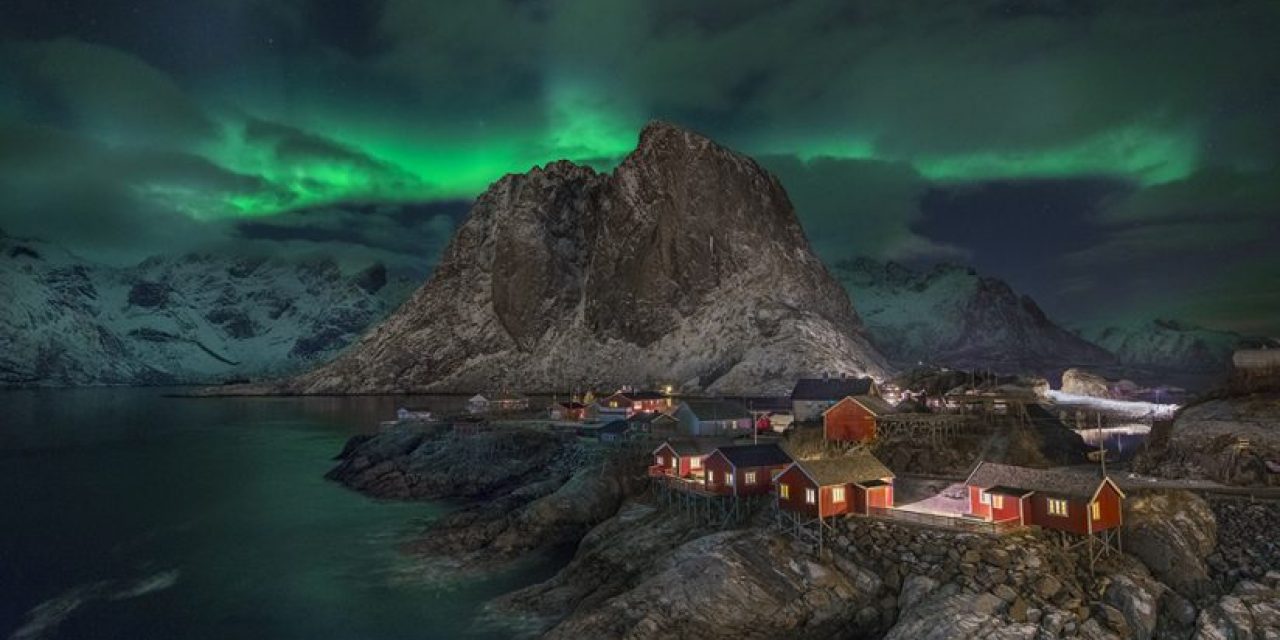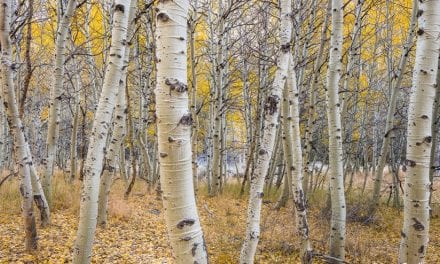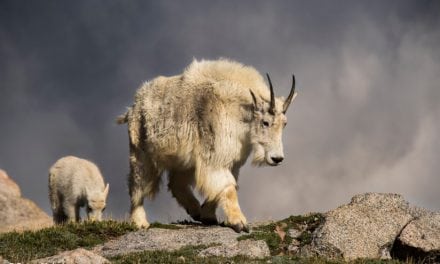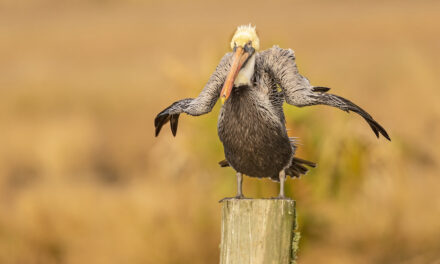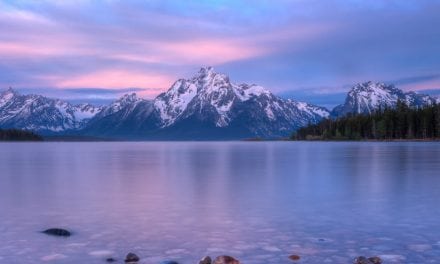There are a lot of ways to improve your chances of creating crisp, vibrant and stunning travel photos. These are some of the techniques I teach my guests on my photography tours to places like Japan, Italy, Jordan and Myanmar to help them take better travel photos.
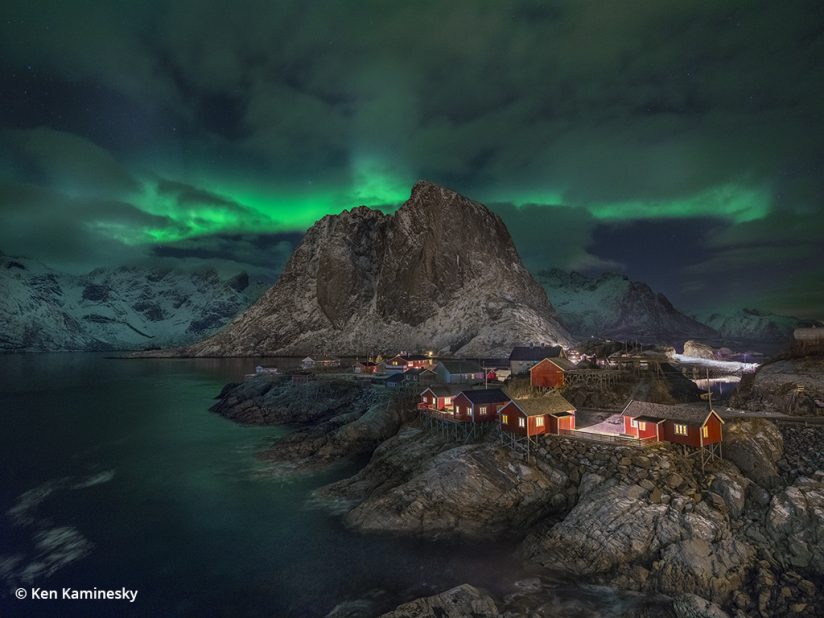
A passion for making and editing photos is essential for improving your photography. The key to keeping that passion in your soul is to continue to have fun with all aspects of the craft. So don’t fret too much if, at first, you’re not getting the results you are looking for. After all, Rome wasn’t built in a day.
Planning Your Shots
“Plans are nothing; planning is everything.” –Dwight D. Eisenhower
Whether you’re close to home or halfway around the world, nothing is more important than proper planning of your shoot if you expect to achieve any high standard of quality with your travel photography. That being said, oftentimes even the best thought-out plans can fall apart. This is why the act of planning is far more important than your actual plans. Planning properly makes you do the research for your locations and allows you to quickly come up with contingencies in case something goes awry once on site.
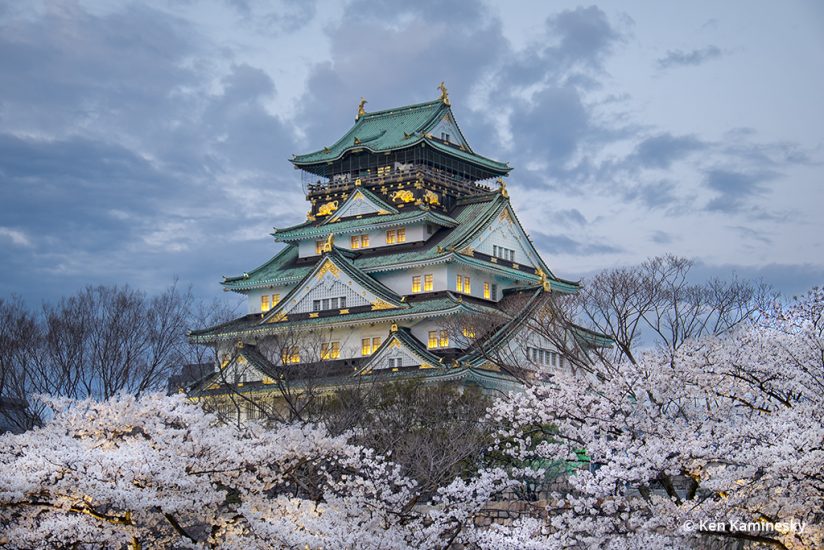
Things to research:
- Sunrise, sunset, “blue hour” times and sun position. There are great apps available for this. My favorite is PhotoPills.
- Dressing for the temperature and weather conditions will allow you to be in top form when shooting. Remember, the temperature will drop while you’re standing around waiting for that big blue hour shot. Staying warm and dry in cold locations, or cool and shielded from the sun in tropical destinations, is going to make you feel better and allow you to photograph in comfort.
- Opening and closing times of national parks, historic sites and other inspiring locations.
- Is your location undergoing renovation and beneath layers of scaffolding? Are there any seasonal or temporary obstructions, like Christmas trees, billboards, booths or other eyesores, that you can plan around and avoid?
- Find out where to purchase a local SIM card for your mobile phone. Being connected locally is such a big bonus when in a foreign place. Don’t forget to “unlock” your phone so that you can use carriers other than your domestic service provider.
- Vantage points. Do some online research and network with local photographers and photography communities to find the best views and determine how to access those areas. If you don’t ask, you may never know. Social media travel groups and photography groups are also excellent resources.
Set It Up
While I appreciate candid photos, there is nothing like having control of a situation, and staging portraits and cultural shots can be fun.
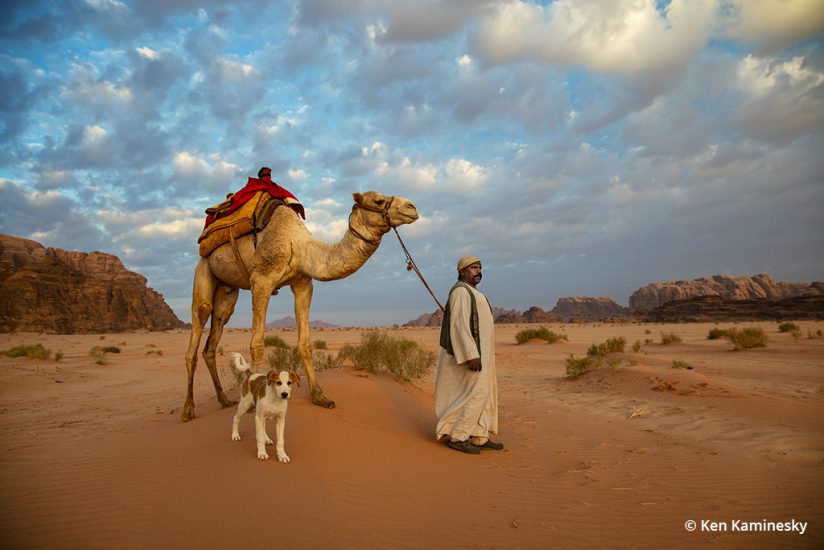
Never be shy to ask people to pose for you. While some people will say no, you’ll be surprised at how many say yes if you seem friendly and happy. Women photographers have a definite advantage over men with this tip as they can appear friendlier and less intimidating than a single man who is asking women or children to pose for him.
Consider renting props as we did in my photo with the camel on my Jordan tour a few years ago. The dog was an unexpected bonus and the icing on the cake. I got both the planned shot along with the spontaneity of having the dog pop in for a cameo. Truly the best of both worlds.
Playing It Safe
I can replace a camera or a lens, but I most certainly cannot replace a one-of-a-kind photograph. This is why I always play it safe and back up all my digital information with a variety of rugged and dependable portable hard drives.
On the road, I transfer all my RAW files directly to two portable hard drives as well as to my laptop hard drive. There’s a common saying in the tech world: “If it’s not in three places, it does not exist.”
I also keep the two portable drives in separate bags or locations. In case something happens to one (theft, fire, loss, etc.), I still have a back-up copy or two.
If your camera has a second memory card slot, another way to help ensure your image files are safe and backed up is to set your camera to use that slot to save a duplicate copy of every image. Cards are cheap today, and your photos are priceless.
In my home office, I transfer the RAW files onto two mirrored RAID systems that use RAID 5. This ensures that all my photos and other digital assets are extremely well protected. I also keep all this data backed up onto a set of off-site drives. If ever there was a fire, flood or theft at my office, my business won’t be ruined, and all my photographs are protected and secured off-site.
Staying Focused
“You can’t depend on your eyes when your imagination is out of focus.” –Mark Twain
Achieving an in-focus photo is key when doing any kind of photography, and with travel photography this is crucial. With innovations like focus peaking on today’s mirrorless cameras, focusing manually is more accurate than ever before. I rarely use autofocus unless I am shooting moving objects handheld.
- The use of a good tripod is a must. More on this later.
- Learning how to focus stack in Photoshop will greatly improve the sharpness of your photographs.
- Stick to apertures of ƒ/8 to ƒ/16 to get the ideal sharpness where most you want it in your frame.
- Keep the ISO as low as possible. Digital noise will make your images look soft.
- When using a tripod, turn off your lens stabilization if possible. It can cause micro tremors in the lens when there is nothing to stabilize.
- You get what you pay for. Use a high-quality lens. There is usually a good reason why better lenses are more expensive.
- Use your camera’s two-second timer when shooting on a tripod. This will give your camera the chance to stop vibrating from even a minor shake.
- Don’t use UV/Skylight filters. Why put an extra bit of glass that can get dirty on two sides in front of your awesome lens?
- Adjust your diopter. You may think you don’t need glasses, but…
- Learn to sharpen images in post-production. You’ll thank me later.
The Beauty Of Blue Hour
Most photographers know about the beautiful soft light of sunset and sunrise otherwise known as the “golden hour” or “magic hour,” but don’t forget about “blue hour.” This is my absolute favorite time to shoot.
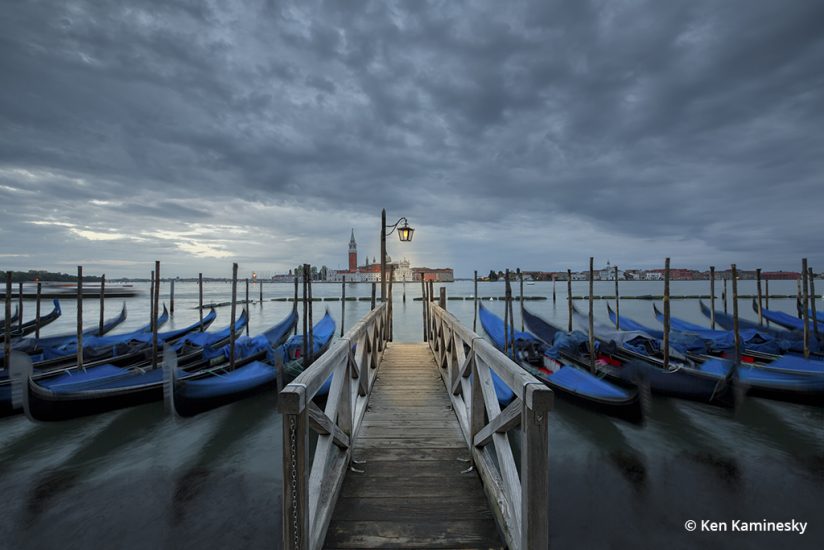
Blue hour is that brief time before sunrise and after sunset where the natural ambient light turns to a beautiful hue of blue. The contrast of the soft blue light and the warm glow of street lamps and other city lights make for some very stunning images. This is where I will be able to capture some of the best photos on any given day.
Not only is blue hour stunning in cities and towns but out in the wild as well. This magical light is also wonderful for landscape photography. The softness of the light is what is so special about it. While you may have more dramatic lighting at sunrise or sunset, there is a gentle calmness about the muted tones and subtle ambiance at blue hour.
No Light? No Problem
When darkness falls, don’t rush to put your camera gear away. Cities tend to come alive in a very different fashion after dark. I like to equate it to putting on formalwear for a night out. Buildings get illuminated and street lamps cast their amber glow and bathe cities in their warm embrace.
Whether it’s a simple street scene or a wide-view cityscape, night photography can provide you with some rather spectacular final images. Places with no photographic appeal during the day may transform into vivid scenery at night.
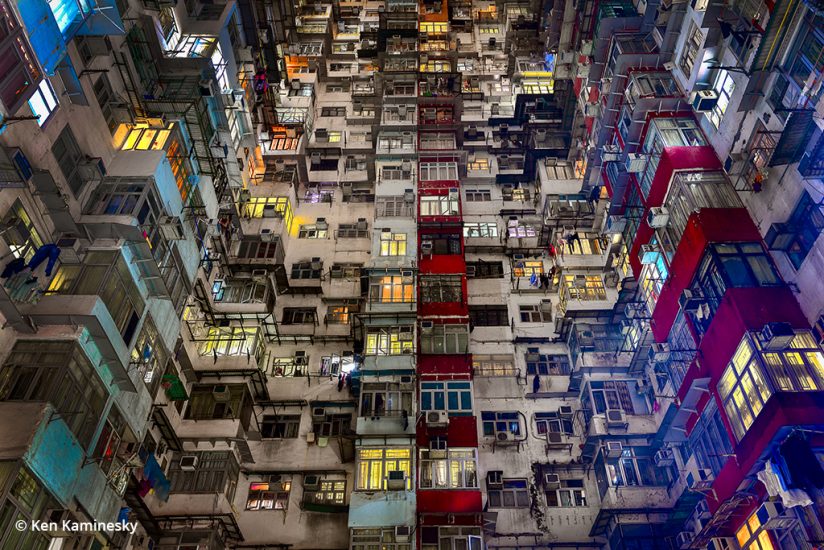
Neutral density filters can be used at night to create very long exposures that remove people completely from the scene. Nighttime shooting will expand your creative horizons and allow you to have fun with your photography in a brand new away.
Location, Location, Location
“If you want to be a better photographer, stand in front of more interesting stuff.” –Jim Richardson
I’m fortunate because my travel photography work takes me to spectacular places around the world. However, it’s amazing what kind of treasures you can find near home. Whether shooting distant locations or near your home, you will find a little research reveals stunning locations to photograph.
One technique to improve your photography is to find an epic location near your home and return there several times. Shoot the same location before and after the sunrise, and before and after the sunset. Examine the area during different lighting conditions, different seasons and at night.
This “study” of a single scene will help you hone your craft and prepare you for making an incredible photograph once you’ve taken the plunge and traveled to a far-away location. It doesn’t cost any more these days to take tons of photos with digital cameras, and you just might surprise yourself by making an iconic photograph of your home area.
The Early Bird
Sunrise is not just a great time for outdoor photography. Getting up well before the crack of dawn can help you get some awesome interior photos, too. If you want to photograph historic sites and tourist hot spots, get there well before opening times so that you can be the first one in line when the venue opens. You may get only one good shot without people in it, or you may get a whole bunch. That depends on the venue and time of year. Even if you get only one great shot, it will be worth it.
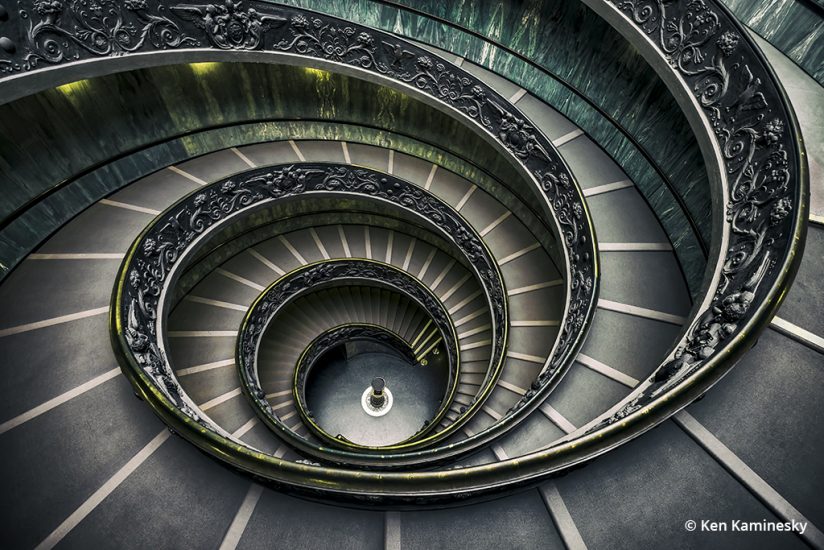
The photo of the Bramante Staircase at the Vatican Museum in Rome is a great example of this. I get my Italy photo tour guests VIP access at the Vatican Museum so that we can be the first ones into the museum as it opens. This gives us a brief chance to get this iconic photograph with no people in it.
Always be mindful of local laws and customs, and if you’re on private property, be sure to get the permission needed to take photos. Knowing your rights can help you if you get stopped by police or security. Oftentimes they don’t know the laws and how they apply to photographers, so have a copy with you if you think you’ll be in a situation where you may need to share these details with anyone else.
Asking permission ahead of time—when possible—is never a bad idea.
Stability, Depth & Sharpness
Tripods are one of the most important tools for shooting just about any kind of scene other than fast-moving objects or street scenes. Don’t skimp on your tripod and buy something flimsy. You spent a lot on your camera and lenses; a good, solid tripod will allow you to take the best advantage of that awesome camera system of yours.
Why use a quality tripod?
- Tripods allow you to get multiple exposures of the exact same scene, which you can then blend in Photoshop using HDR techniques, Luminosity Masking and other techniques for digital blending.
- It’s impossible to shoot long-exposure photography without a tripod.
- Tripods make you take time to compose and frame your shot properly.
- You can achieve increased depth of field by shooting at smaller apertures.
- You’ll get in-focus and sharp images with a camera on a tripod. Hand-holding will often lead to blurry images, even at higher shutter speeds.
- Tripods are invaluable when using focus stacking to get your whole scene in focus from foreground to background.
- One word: Astrophotography.
The Four Ps To Take Better Travel Photos
Practice. No artist will ever get better at their craft without serious amounts of practice. The good thing is, practicing in photography is fun. Keep shooting in new ways and experimenting with new techniques.
Never stop learning. With the internet at your fingertips, there is no excuse not to continue to learn and grow as a photographer. Use YouTube as your first way of searching how to do new things in photography. Video is a great way to learn. For more in-depth ways to learn specific styles and genres, take the plunge and buy a photo tutorial from a photographer whose work you admire. Alternatively, you can take a class or attend a seminar locally. Be sure to check out who is teaching and review their work online before signing up, That way you’ll be more likely to be learning the actual techniques you’re interested in.
Patience. Don’t expect every shot to be amazing nor think that every time you try something new it will be a giant success. You’ll learn a lot from your failures. The trick is, only show people your best work.
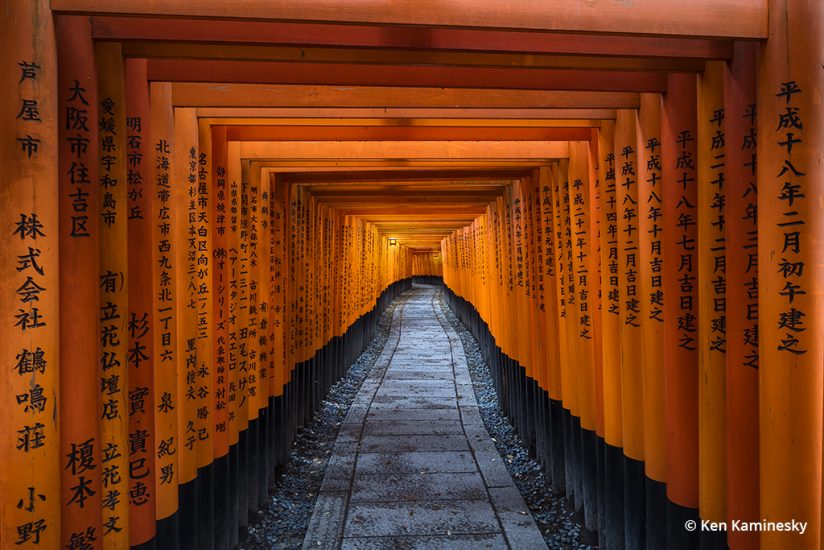
When asked about his 10,000 failed attempts at creating the light bulb, Thomas Edison replied: “I have not failed. I’ve just found 10,000 ways that won’t work.”
Patience also applies to waiting until people are out of your shot, like in my image of the Tori gates in Kyoto. I probably waited 30 minutes to get the shot with no one walking through the scene.
Persistence. Don’t give up! Good things don’t happen to those who simply wait; they happen to those who work their butts off. Don’t be distracted by negative thoughts and give up. The next shot may be the perfect one.
Photoshop. Capturing a great image is just the beginning. Learning how to bring your vision to life by post-processing with the powerful software available to photographers today is the icing on the cake. You’ll never regret getting really good at Photoshop. Trust me.
Breathe
“When you arise in the morning, think of what a precious privilege it is to be alive—to breathe, to think, to enjoy, to love.” –Marcus Aurelius
One vital aspect of being a creative person is continuously finding ways to remain inspired. When I’m photographing something special, I always try to take a moment and put my camera down to just appreciate where I am and be grateful. Humility and gratitude in these epic locations seem not just appropriate but quite fitting. It’s the least I can do when trying to pay homage to the place I’m photographing.
I believe that I’m not just creating photographs but building memories for myself. The photos that I take and look at for years to come will always bring me back to this moment where I took the time to absorb the sights, smells, tastes and every other aspect of the place I’m in. I don’t want to remember every single place I visit with the obstruction of a camera in front of my face.
I now own those captured moments forever, and they will inspire me to continue on my quest to find the next soul-stirring place to photograph.
The post Take Better Travel Photos appeared first on Outdoor Photographer.

